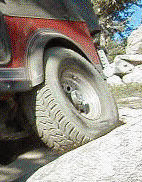1. An air pump is cheap.
2. Ryobi makes a cordless air pump. Loud, but very useful.
3. Load range E is stiffer in the tread- To keep it uniform contact patch even under pressure and load. Anyone who has mounted tires knows there's a significant difference in flexibility.
Yes, a f350 with a camper aired down to 15 will spread some- but E range tires are generally designed purposely to not spread. E ranges are used heavily on dual wheels, where spread would allow tire to tire rubbing.
Likewise, using E range tires on a f150 will not spread nearly as much.
Im a huge fan of E range tires though. The ride is not as comfortable, though the safety from sidewall cuts, blow outs, potholes, etc are usually better.
When I used to offroad (not expo style- just offroad for offroading) we used to spray down the side walls with tire shine. Mud/sun dries out the tires- tireshine not only protects the tire from UV and drying out, it acts as a lubricant so that the tire can more likely take a glancing blow from a sharp edge.
2. Ryobi makes a cordless air pump. Loud, but very useful.
3. Load range E is stiffer in the tread- To keep it uniform contact patch even under pressure and load. Anyone who has mounted tires knows there's a significant difference in flexibility.
Yes, a f350 with a camper aired down to 15 will spread some- but E range tires are generally designed purposely to not spread. E ranges are used heavily on dual wheels, where spread would allow tire to tire rubbing.
Likewise, using E range tires on a f150 will not spread nearly as much.
Im a huge fan of E range tires though. The ride is not as comfortable, though the safety from sidewall cuts, blow outs, potholes, etc are usually better.
When I used to offroad (not expo style- just offroad for offroading) we used to spray down the side walls with tire shine. Mud/sun dries out the tires- tireshine not only protects the tire from UV and drying out, it acts as a lubricant so that the tire can more likely take a glancing blow from a sharp edge.




![2894938A[1].jpg](https://lh3.googleusercontent.com/-zj3keBKOwRo/UwYnsqywGeI/AAAAAAAAAW4/7GvQJFZ5shI5mv_SOKgJ31mkIShZGWVPQCCo/s400/2894938A[1].jpg)
